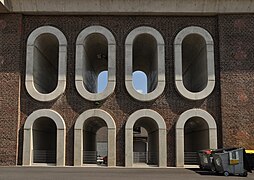Burtscheider Viaduct
Coordinates: 50 ° 46 ′ 3 ″ N , 6 ° 5 ′ 46 ″ E
| Burtscheider Viaduct | ||
|---|---|---|
| Burtscheider Viaduct, view from the southwest in 2011 | ||
| Convicted | High-speed line from Cologne to Aachen | |
| Subjugated | Jägerstrasse, Bachstrasse, Moltkestrasse | |
| place | Aachen | |
| Entertained by | DB network | |
| overall length | 250.80 m | |
| width | 8.90 m (masonry) 10.24 (superstructure) |
|
| Number of openings | 27 | |
| Clear width | 12.58 m (large arches) 5.99 m (small arches) |
|
| height | 17.80 m (including concrete deck slab) | |
| Clear height | 14.50 m | |
| start of building | 1838 | |
| opening | September 1, 1841 | |
| planner | AE Pickel, F. Wittfeld | |
| location | ||
|
|
||
The Burtscheider Viaduct was built in 1838–1840 as the first large German railway viaduct by the Rheinische Eisenbahn-Gesellschaft and is one of the oldest railway bridges in Germany that is still in use. It is located in the apron of Aachen Central Station on the Cologne – Aachen railway line .
Rail transport
The Burtscheider Viaduct is located on the double- track Cologne – Aachen railway line between the Rothe Erde and Aachen Hauptbahnhof stations . In international long-distance traffic in an east-west direction, this is the only main route to Belgium. Five pairs of Thalys trains run between Cologne and Paris and seven ICE 3 trains from Frankfurt via Cologne to Brussels (as of 2020). Regional traffic in the direction of Stolberg and Düren, as well as extensive national and international freight traffic, also cross the bridge.
construction
According to plans by engineers AE Pickel and F. Wittfeld, the construction of the viaduct over the Wurmtal (at that time Kalter Bach and Warmer Bach ) in Burtscheid began. The bridge was opened on September 1, 1841. The structure was originally 277 meters long and up to 16 meters high and was entirely made of brick .
From the eastern abutment, three arches begin with a 2.7 meter span. This is followed by a row of arches with eight large arches, each with a span of 12.2 meters. This is followed by a so-called "dissolved abutment", a large central pillar with four arches in two rows one above the other. This is followed by a further eleven arches, each with a 6 meter span. Finally, at the western abutment, there was the overpass over Kurbrunnenstrasse. On October 16, 1944, shortly before the Allies took Aachen, this overpass was blown up by an SS commando. The destroyed arch was replaced by a steel bridge after the war. The length of the brick viaduct is now 251 meters.
Multiple expansion
- In the course of the electrification of the double-track line in the mid-1960s, a concrete slab was applied. The superstructure width is now 10.24 meters. In the 1980s, the underside of the large arches was also covered with shotcrete.
- Measurements on the structure in 2006 showed that the load-bearing capacity of the construction was no longer sufficient and no longer met the requirements of a modern railway infrastructure. In an extensive renovation concept in 2007–2009, the masonry arches were supported by a new reinforced concrete shell construction and the loads from the large vaults were supported by additional beam grating systems based on piles. These measures had to be carried out without interfering with the rail traffic on the main Cologne – Aachen line, and without changing the overall historical impression of the listed building too much.
Picture gallery
Web links
Individual evidence
- ^ Course book section 480 Aachen - Cologne on vonderruhren.de
- ^ A b Franz-Josef Knoblauch, Andreas Laubach, Wolfgang Sauer, Michael Schmidt, Peter Sprinke: Renewal of the Burtscheider Viaduct in Aachen , concrete and reinforced concrete construction 103 (2008), volume 3







